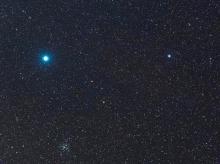Listen to today's episode of StarDate on the web the same day it airs in high-quality streaming audio without any extra ads or announcements. Choose a $8 one-month pass, or listen every day for a year for just $30.
You are here
Second Dog
There’s more than one way to look at the stars. With our eyes alone, we see only a sliver of the spectrum of energy a star radiates into space. But our instruments see the entire spectrum. And as we tune up and down that spectrum, different forms of energy become more prominent.
Consider Adhara, the second-brightest star of Canis Major, the big dog, which is in the southeast by mid-evening.
The constellation’s brightest star is Sirius. It’s the brightest star in the night sky — but only at visible wavelengths.
Adhara is well to Sirius’s lower right, and doesn’t look nearly as impressive. But it’s actually thousands of times brighter than Sirius. It looks fainter because it’s hundreds of light-years farther.
But if you could tune your eyes to the ultraviolet, Adhara would far outshine Sirius. In fact, it would be the brightest star in the night sky.
That’s because Adhara is quite hot, and hot stars produce most of their energy in the ultraviolet. Adhara is also big, so there’s a lot of star to radiate energy into space. The combination makes Adhara a brilliant ultraviolet beacon.
That won’t always be the case, though. In a few million years, the star’s outer layers will puff up. That’ll make the surface much cooler, so Adhara’s ultraviolet light will fade. Instead, the star will blaze in another band — as one of the brightest infrared sources in the sky.
We’ll talk about the big dog’s third-brightest star tomorrow.
Script by Damond Benningfield





